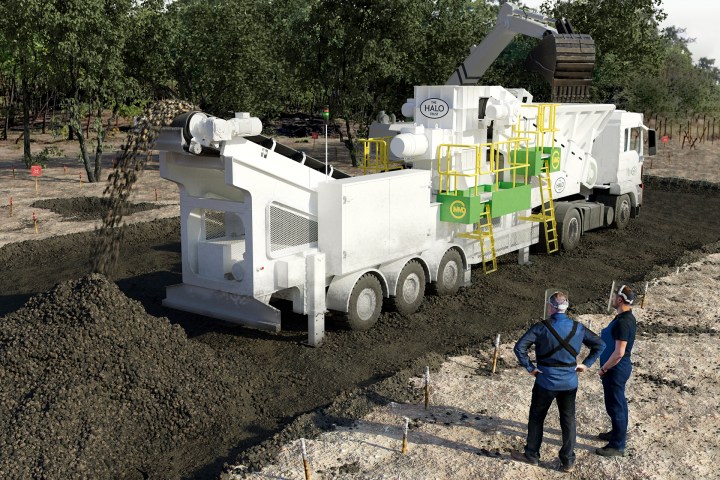
For the person with a hammer, every problem they see is a nail. And for a person working for the one of the world’s biggest anti-landmine organizations, every bit of technology is a possible de-mining tool. That’s what happened with Tom Meredith, regional director for the HALO Trust, back in 2012.
“It was crucial that it would work, since even letting a single mine through by accident would be unacceptable.”
HALO as an organization has been working toward its goal of a landmine-free planet since 1988. While things have certainly improved since then, its goal is in no way complete. Landmines continue to represent a terrible plague on the world, maiming or killing an estimated 15,000 to 20,000 people every year. Of these, children account for one in five victims.
To remove these mines, HALO has thousands of employees around the world, many of whose job is to spend long days on mine field manually locating the explosives with metal detectors and then digging them out by hand.
In the case of one particular site, however, that approach simply wasn’t going to cut it. And Meredith was struggling to come up with an answer.
The trouble with soil
“We had this problem of how to process wet, sticky soil,” he told Digital Trends. “One area we were working with had these plastic anti-personnel mines, which are very difficult to find with a metal detector. These were mixed in with some of the stickiest soil you can imagine. We had no easy way of dealing with it.”
Things changed when a chance connection led to him being linked up with a U.K.-based machinery company called MMD.
MMD — short for Mining Machinery Developments — builds innovative mining equipment, designed for handling a wide variety of soil types, from hard and abrasive to wet and sticky. One of its digger-like machines was used for chewing up tough ground full of clay and rocks and breaking it into tiny chunks of 25mm or less. Meredith wondered whether it could do the same for landmines.
Using one single rig, HALO and MMD believe it should be possible to destroy 100,000 mines by 2025.
He reached out to the company, and found they were receptive. So receptive, in fact, that they offered to not only donate one of their vehicles to the HALO Trust, but to actually build an entirely new scaled-down machine which could be easily deployed on minefields around the world.
“It was a use for one of their machines that they had never considered before, and one which carried a real human benefit,” Meredith continued. “They knew that the core principle of their technology — taking big lumps of rock and making smaller ones — was up to the job, but they’d never made anything like this before. They had to adapt their whole ‘sizer’ unit in order to accomplish this task. It was crucial that it would work, since even letting a single mine through by accident would be unacceptable.”
The landmine muncher
Six years of research and development later, and MMD has delivered its awesome final product: a mine-munching tank of a machine, weighing 30 tons, and capable of chewing through 50 tons of soil every hour. This soil is loaded into the armored rig and then fed through two sets of rotating steel teeth called “sizers.”
While the mines do detonate inside the machine, the 150 grams of high explosive each mine packs has about as much impact as a tiny pothole does on a tractor. Using one single rig, HALO and MMD believe it should be possible to destroy 100,000 mines by 2025.
“It will be heading off to Zimbabwe within a month or two,” Meredith said, referring to the African country where thousands of landmines were laid along its borders during the Liberation War of the 1960s and 70s. Even today, there are an estimated 5,500 unexploded landmines per 3,000 cubic feet in these zones.
“Once it’s out there, there will be a period of testing and accreditation. But we hope it will then be out in the field destroying mines before the end of the year.”
The future of anti-landmine tech
Landmine-munching machines aren’t the only example of smart tech intended for this task. Previously at Digital Trends, we’ve covered other innovative initiatives, such a project to use drones to locate landmines, one that uses lasers and fluorescent bacteria for the same task, and even one based around an army of oddball robot turtles.
“It’s rarely a perfect football pitch with a precise pattern of mines for you to go and spot.”
“We have a lot of really bright ideas that come across our desk,” Meredith said, discussing the future of landmine-eliminating technology. “Sometimes it comes from military use, sometimes it’s from commercial companies, other times it’s just your stereotypical inventor in their garage conjuring up clever tools.”
While he warns that the issue is more complex than some expect (“It’s rarely a perfect football pitch with a precise pattern of mines for you to go and spot”), it’s out-of-the-box thinking like this that will lead to a world in which injuries and deaths by landmine are relegated to be a terrible relic of the past.
Most important of all is to keep your eyes and ears open. Because you never know when a chance comment about a piece of ground-chewing agricultural machinery could change the game.






